Pyrrhulomyces astragalinus (Fr.) E.J. Tian & Matheny, comb. nov. FIG. 4A–D, 6A
MycoBank number: MB 835047; Index Fungorum number: IF 835047; Facesoffungi number: FoF;
≡ Agaricus astragalinus Fr., Syst Mycol 1:251. 1821 (basionym).—Flammula astragalina (Fr.) P. Kumm., Der Führer in die Pilzkunde:82. 1871.—Dryophila astragalina (Fr.) Quél., Enchiridion Fungorum in Europa media et praesertim in Gallia Vigentium:71. 1886.— Gymnopilus astragalinus (Fr.) Imai, Journal of the Faculty of Agriculture of the Hokkaido Imperial University 43:234. 1938.—Pholiota astragalina (Fr.) Singer, Lilloa 22:516. 1951 [1949].
= Gymnopilus laeticolor Murrill, Mycologia 4:251. 1912.—Flammula laeticolor Murrill, Mycologia 4:251. 1912. Selected illustrations: Lincoff (1981), Bessette et al. (1995), Holec (2001), Phillips (2005), Trudell and Ammirati (2009).
Pileus 20–60 mm broad, hemispheric, obtusely conic to convex with an obtuse umbo, margin wavy and with fibrillose remains of the veil, otherwise glabrous or with innate fibrils, viscid when wet; brilliant pinkish orange to ochraceous orange or ochraceous salmon, hygrophanous, fading in age and soon developing blackish dis- coloration; context thin to moderately thick, pale orange, reddish to reddish brown in KOH; odor mild, taste bitter. Lamellae adnexed to adnate, sometimes uncinate, close, medium broad, orange yellow to yellowish brown or brown; edges paler, fimbriate; diffusing yellow pigment in KOH mounts. Stipe 40–90(–110) × 4–8 mm, central, cylindrical, flexuous, base often curved; surface dry, fibrillose or with scattered fibrillose scales, pale orange to dingy orange at base; veil evanescent, pale yellow or whitish, at times forming a cobwebby annulus; context stuffed or hollow; base of stipe without acanthocytes and astrocystidia.
Basidiospores 6–6.8–8 × 4–4.4–5 µm, Q = 1.33–1.52–1.70(1.78) (n = 42/4), smooth, without a germ pore; elliptic to (sub)ovate in face view, subamygdali- form to elliptic (inequilateral) in profile, apices bluntly pointed to rounded; yellowish brown in KOH, paler in Melzer’s, brown in deposit; slightly thick-walled. Basidia 20–28 × 7–8 µm, 4-spored, narrowly clavate, hyaline to yellowish in KOH and in Melzer’s reagent. Pleurocystidia 42–55 × 12–18 µm, present as chrysocystidia, frequent, typically fusiform, clavate- mucronate, or clavate, with a golden refractive inclusion and hyaline elsewhere or golden ochraceous throughout, thin-walled, smooth. Cheilocystidia 45–72 × 6–7.5 µm, somewhat widened at or near the base with a long and slender neck (2.5–5 µm wide) ending in an obtuse to subacute apex, wall thin and smooth, hyaline to yellowish in KOH. Caulocystidia absent, few clavate end cells reported by Smith and Hesler (1968). Hymenophoral trama of the central area of floccose hyphae subparallel and cells inflated (up to 22 µm wide); wall thin and smooth, hyaline to yellow; subhymenium not gelatinized. Pileus an ixocutis, hyphae 2.5–5 µm wide; wall smooth, hyaline to yellow in KOH; hypodermial region more ochraceous, cells compactly arranged and 8–10 µm broad. Context hyphae interwoven, cells inflated (up to 22 µm wide), smooth, hyaline to yellow. Clamp connections present.
Ecology and distribution: On logs, stumps, and rotting conifer wood in late stages of decay (rarely on hardwood per Holec 2001), widely distributed across Europe, East Asia (China), and northern parts of North America southward to northern California along the coast and southward into the southeastern United States at high elevations, with molecular confirmation from Europe (Italy, Sweden, Switzerland), Asia (China), and North America (Alaska, British Columbia [MN954743], Washington, Idaho, Newfoundland and Labrador, Maine, North Carolina, and Tennessee). Mostly late summer to fall, Aug, Sep, Oct, rarely Jul, late fall to winter (Nov to Feb) along the northern California coast.
Specimens examined: USA. ALASKA: Juneau, Windfall Trail, 58.5, −134.71944, 21 Sep 1995, J.A. Stevenson TFB7720 (TENN-F-054310), GenBank: ITS = MN209722; IDAHO: Burgdorf, 45.27694, −115.91278, on conifer log, 22 Aug 1958, A.H. Smith AH60388 (TENN-F-028808), GenBank: ITS = MN149357; MAINE: Piscataquis, south of Baxter Park, 45.9325, −69.18861, 22 Aug 1962, H.E. Bigelow RHP28708 (TENN-F-028708), GenBank: ITS = MN209725; NORTH CAROLINA: Mt. Mitchell State Park, Yancey County, Balsam Nature Trail, 35.765, −82.2652, solitary on conifer log in Abies fraseri forest mixed with some Picea rubens and Betula, 28 Sep 2019, J. Kalichman PBM4330 (TENN-F-074962), GenBank: ITS = MT187979, 28S = MT228845; TENNESSEE: Great
Smoky Mountains National Park, Indian Gap, 35.6092, −83.4464, at base of decaying stump, 27 Aug 1949, L.R. Hesler LRH19298 (TENN-F-019298), GenBank: ITS = MT187983; ibid., at base of stump in Picea woods, 27 Aug 1950, S.L. Meyer LRH19715 (TENN-F-019715), GenBank: ITS1 = MT192224, ITS2 = MT188030; ibid., on decaying Picea log, 15 Sep 1951, L.R. Hesler LRH20178 (TENN-F-020178), GenBank: ITS = MT187982; Great Smoky Mountains National Park, Mt. LeConte, 35.655, −83.441, on log, 29 Aug 1966, R.H. Petersen RHP29369 (TENN-F-029369), GenBank: ITS = MT187981; Great Smoky Mountains National Park, Appalachian Trail north- east of Clingmans Dome, 35.5630, −83.4986, scattered to caespitose on standing dead log (likely conifer), 7 Sep 1991, S.C. McCleneghan TFB4602 (TENN-F-052742), GenBank: ITS = MT187980; WASHINGTON: Mt. Rainier National Park, 46.71917, −121.91861, on conifer log, 5 Oct 1952, A. H. Smith AHS40599(TENN-F-028138), GenBank: ITS = MN149363. CANADA. NEWFOUNDLAND AND LABRADOR: Division 1, Holyrood, Salmonier Nature Park, 47.27333, −53.28472, 13 Sep 2006, M. Voitk MV12616 (TENN-F-061287), GenBank: ITS = MN209724. SWEDEN. Halleborg Mountain, 58.37778 12.44444, on wood, 21 Sep 1991, R.H. Petersen TFB4226 (TENN-F-050562), GenBank: ITS = MN209726. SWITZERLAND. Lucerne, Willisau, Wellberg, 47.12639, −8.01806, on conifer wood, 1 Oct 1970, M.M. Moser MOS70/345 (TENN-F-037128), GenBank: ITS = MN149358. CHINA. JIANGXI PROVINCE: No metadata available, HFJAU432, GenBank: ITS = MN258673; JILIN PROVINCE: Antu County, Erdaobaihe, 6 Jul 2000, Tolgor Bau (HMJAU3064).
Comments: The description of Pyrrhulomyces astragalinus above is a composite taken from notes of multiple collections cited in Smith and Hesler (1968) confirmed as monospecific by molecular annotations. The microscopic description is our own. Pyrrhulomyces astragalinus is a common and widespread species in Europe, East Asia, and northern regions of North America descending into the high elevations of the Southern Appalachians in coniferous forests and south- ward along the coast in northern California. The species is characterized by the brightly colored orange to salmon-orange viscid pileus, bitter taste, abundant pleurochrysocystidia, and unusually narrow cheilocystidia with a long slender neck. Holec (2001) reported the spores as smooth (under typical light microscopy) or finely punctulate in Mezler’s reagent using a high- quality oil immersion lens. The spore surface to us appeared smooth in KOH and Melzer’s. We agree with Holec (2001) that a germ pore is not present or at least not visible, in contrast to that observed by Smith and Hesler (1968), who reported the presence of a minute germ pore. Holec (2001) also reported a distinct rugulose ornamentation on the surface of the basidiospores under SEM based on a study by Jacobsson (1991).
In phylogenetic analyses, this species, together with Pyrrhulomyces amariceps, formed a separate clade apart from Pholiota and close to Stropharia, Hypholoma, and Bogbodia, the latter including Naematoloma longisporum (FIGS. 1–3), with strong support values. However, it is not clear, of these genera, which is the sister group to Pyrrhulomyces. Molecular data (ITS and 28S) best distinguish Py. astragalinus from Py. amariceps at this stage. Jacobsson (1991) designated a neotype from Sweden on a decaying pine stump.
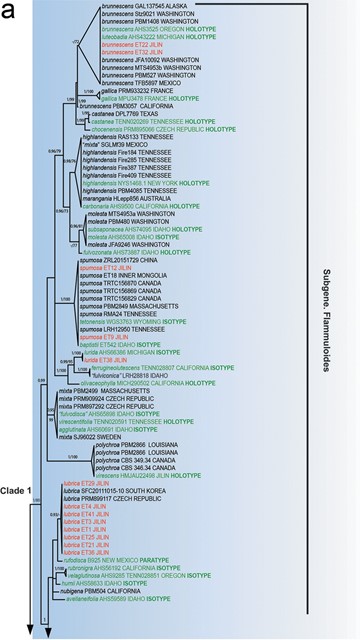
Figure 1. BI phylogram of Pholiota and allied genera based on data set 1 (ITS+28S+rpb2). PPs >0.90 and bootstrap values >70% are shown. Types are indicated in green, and specimen vouchers from China are in red.
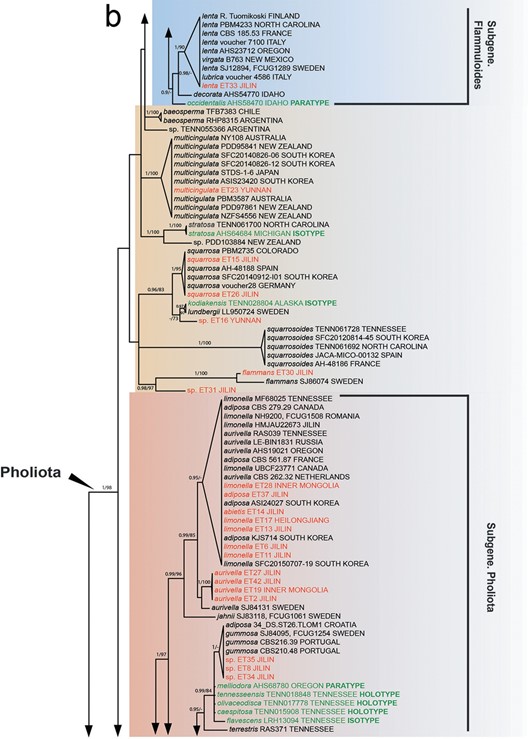
Figure 1. (continued.)
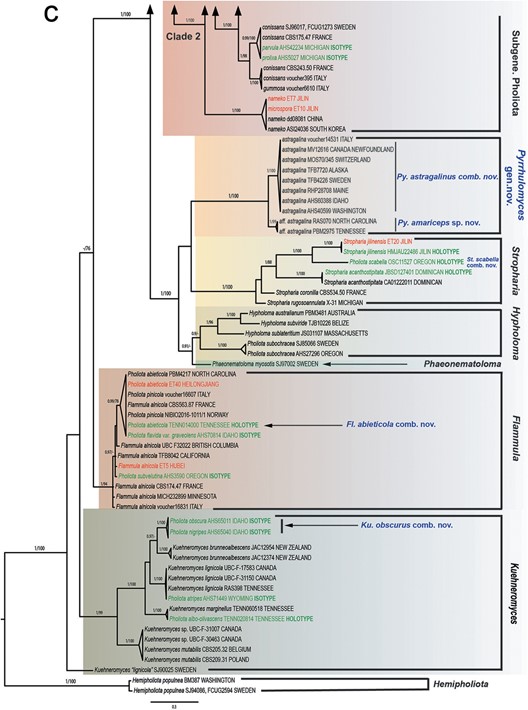
Figure 1. (continued.)
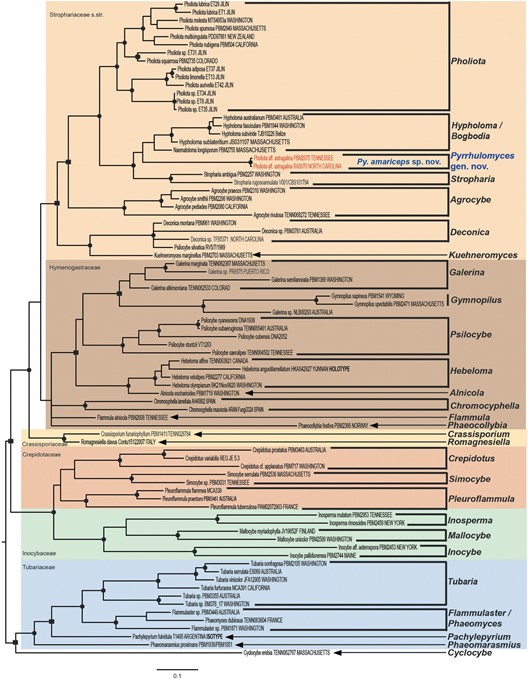
Figure 2. BI phylogram of Strophariaceae and other selected families of Agaricineae based on data set 2 (28S+18S+rpb2+tef1). Nodes with bootstrap values >70% and PPs >0.95 are indicated with black-filled circles. Nodes with bootstrap support <70% but PPs >0.95 are indicated with black-filled squares. Nodes with bootstrap support >70% but PPs <0.95 are indicated with black-filled hexagons.
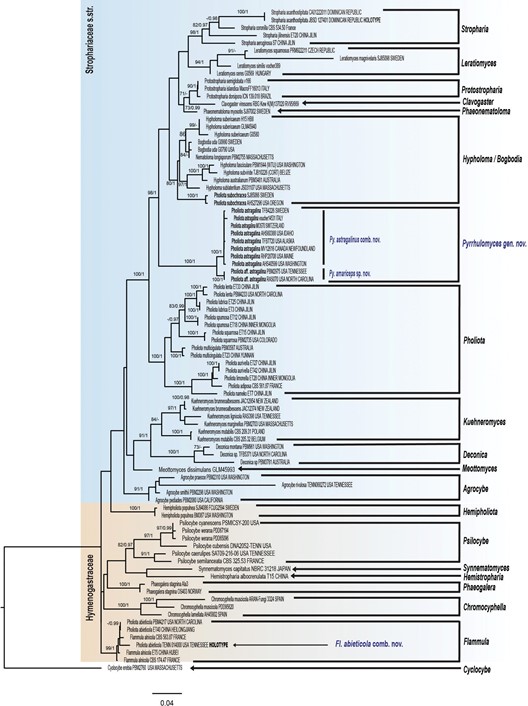
Figure 3. ML phylogram of genera of Strophariaceae and selected Hymenogastraceae inferred from data set 3 (ITS+28S). Bayesian PPs >0.95 and bootstrap values >70% are shown.
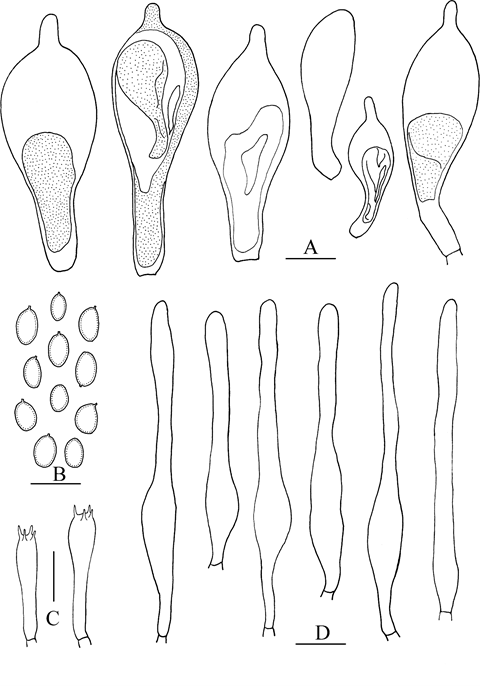
Figure 4. Microcharacters of Pyrrhulomyces astragalinus (TENN-F-028808). A. Pleurocystidia. B. Basidiospores. C. Basidia. D. Cheilocystidia. Bars = 10 µm. Drawings by E.-j. Tian.
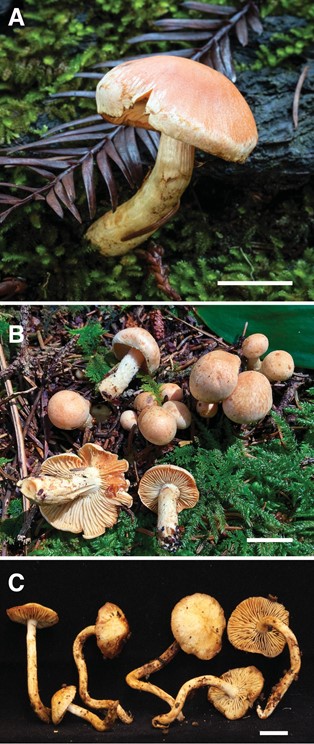
Figure 6. Basidiomes. A. Pyrrhulomyces astragalinus (MGW1653, northern California). Photo by Mike G. Wood. B. Pyrrhulomyces amariceps (RAS070, North Carolina). Photo by R. A. Swenie. C. Pyrrhulomyces amariceps (PBM2975, holotype, Tennessee). Photo by P. B. Matheny. Bars = 1 cm.
